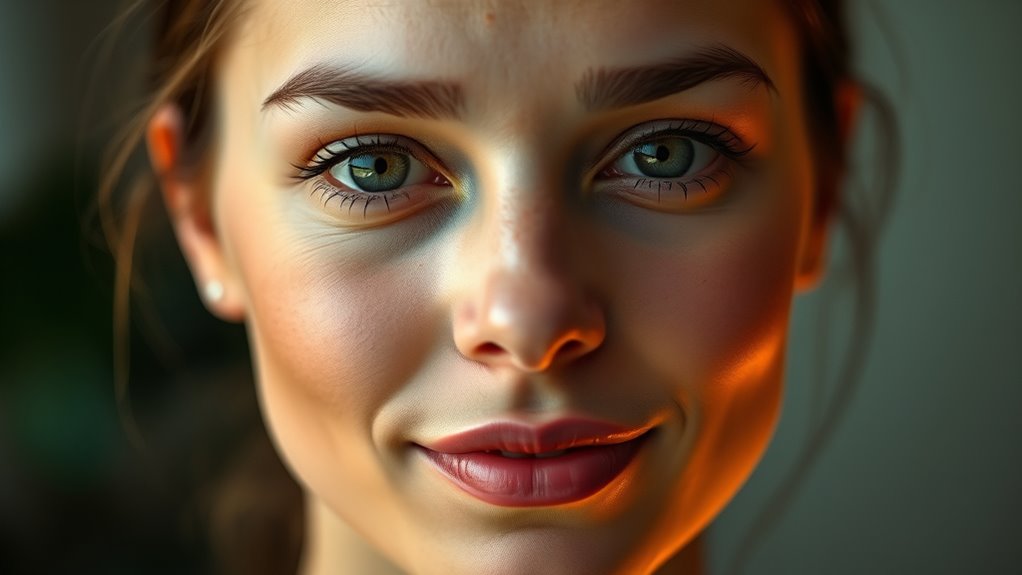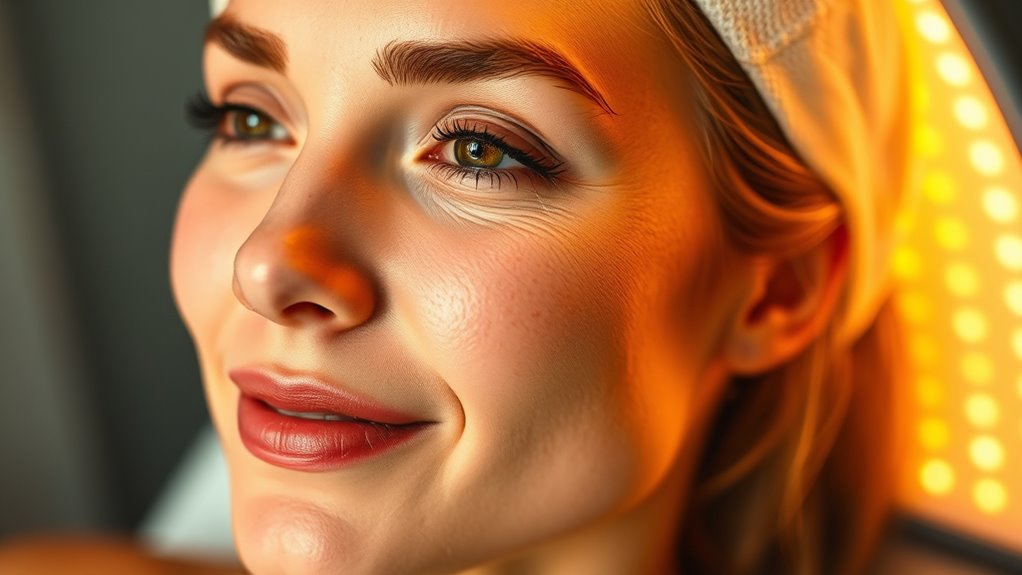Light therapy can gradually reduce dark spots by targeting excess melanin and encouraging skin renewal. However, you need patience and consistency, as improvements don’t happen overnight. Multiple sessions over weeks or months are usually necessary, and small changes are common at first. Protect your skin with sunscreen and avoid harsh products to support your progress. Keep going, and you’ll discover strategies to maximize your results next.
Key Takeaways
- Light therapy gradually breaks down pigmentation, requiring consistent sessions over weeks or months for noticeable results.
- Patience is essential, as visible improvements often appear slowly and vary among individuals.
- Combining light therapy with daily sun protection prevents worsening dark spots and supports treatment progress.
- Small initial improvements are common; celebrating these encourages continued effort and patience.
- Realistic expectations and perseverance lead to clearer, more even skin over time.

Dark spots can be frustrating and difficult to fade, but light therapy offers a promising solution. When you’re dealing with hyperpigmentation, it’s natural to want quick results, but understanding that patience is essential will help you stay motivated. Light therapy works by targeting the excess melanin in dark spots, gradually breaking it down and encouraging your skin to renew. Unlike harsh treatments that can cause irritation or damage, light therapy is gentle and non-invasive, making it suitable for most skin types. However, it’s important to remember that visible improvements won’t happen overnight. You need to commit to consistent sessions and give your skin time to respond.
Patience is key; light therapy gradually fades dark spots without harsh side effects.
As you begin your light therapy journey, you might notice some initial changes, but don’t get discouraged if progress seems slow. The process involves multiple treatments over weeks or even months, depending on the severity of your dark spots. During this time, your skin is gradually adjusting, and the pigmentation is slowly fading. Patience is vital because rushing the process can lead to uneven results or irritation. Keep in mind that results vary from person to person—some may see considerable improvement within a few months, while others might need longer. Staying consistent with your treatments and following your dermatologist’s advice will maximize your chances of success.
It’s also important to combine light therapy with good skincare habits. Protecting your skin from further sun damage by using broad-spectrum sunscreen daily is vital. Sun exposure can worsen hyperpigmentation, undoing any progress you make. Additionally, using gentle skincare products that support skin renewal can enhance your results. Avoiding harsh scrubs or irritating ingredients will help your skin heal and respond better to treatment. Remember, your skin needs time to recover and adapt, so give it the care it needs between sessions.
Furthermore, understanding how various light therapy devices work can help you make better choices and set realistic expectations for your results.
Finally, celebrating small victories along the way can motivate you to stay committed. Even minor fading of dark spots is a positive sign that your skin is responding. Over time, with patience and perseverance, light therapy can greatly improve your skin’s appearance. The key is consistent effort and realistic expectations. By understanding that lasting results require time, you’ll be more likely to stick with your treatment plan and ultimately enjoy clearer, more even-toned skin. Patience truly pays off when it comes to light therapy for dark spots.
Frequently Asked Questions
How Long Does It Typically Take to See Results?
You can usually start seeing improvements in your dark spots within 4 to 6 weeks of consistent light therapy sessions. Keep in mind, results vary depending on your skin type, the severity of the spots, and how regularly you use the treatment. Stay patient and committed, as noticeable fading often takes a few months. Combining therapy with a good skincare routine can help accelerate your progress.
Are There Any Side Effects From Light Therapy?
Like a gentle tide, light therapy usually carries minimal side effects, making it a safe option for many. You might notice mild redness, dryness, or sensitivity shortly after treatments, but these typically fade quickly. Serious reactions are rare, especially when a professional administers the therapy. To keep your skin happy, follow your provider’s instructions, and report any unusual symptoms immediately. Overall, light therapy’s side effects are gentle waves, not storms.
Can Light Therapy Be Used Alongside Other Treatments?
Yes, you can use light therapy alongside other treatments, but you should consult your dermatologist first. Combining treatments like topical creams or chemical peels may enhance results, but it’s important to guarantee they don’t interfere with each other or cause irritation. Your doctor can recommend a safe, effective plan tailored to your skin type and goals, helping you achieve the best outcome while minimizing risks.
Is Light Therapy Safe for All Skin Types?
Light therapy is generally safe for all skin types, but you should consult a dermatologist first. They can assess your skin and recommend the right type of light therapy to minimize risks like irritation or pigmentation changes. Keep in mind that individual reactions vary, so start with a professional’s guidance. Proper treatment, combined with patience, helps you achieve better results safely.
How Often Should Treatments Be Administered for Best Results?
Think of your skin as a garden that needs consistent care. For best results, you should typically undergo light therapy sessions 2 to 3 times a week. This schedule allows the light to work effectively without overwhelming your skin. Remember, patience is key—results may take several weeks to become noticeable. Stick with your treatment plan, and you’ll eventually see those dark spots fade into the background.
Conclusion
Think of light therapy as tending a garden. At first, the weeds of dark spots may seem stubborn, but with patience and consistent care, your skin begins to bloom. Each session is like watering and nurturing, gradually revealing a brighter, more even complexion. Remember, growth takes time—so stay committed. Soon, you’ll see your skin flourish, just like a well-tended garden, proving that patience truly makes all the difference.









